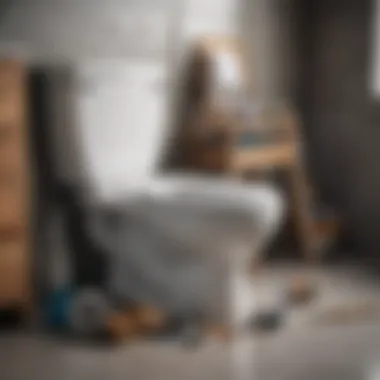Practical Solutions for Fixing a Backed Up Toilet


Intro
A backed up toilet is a common household issue that can disrupt daily life and create discomfort. Understanding how to properly address this problem is essential for maintaining a smooth plumbing system. This article aims to provide a comprehensive guide on diagnosing and fixing toilet backups. We will explore common causes of these blockages, offer detailed troubleshooting steps, and suggest effective solutions. Additionally, preventative measures will be discussed to help avoid future incidents.
Recognizing the signs of a blockage early can save time and minimize damage. The key focus will be on practical, actionable advice tailored for homeowners. Proficiency in basic toilet maintenance can significantly enhance one’s ability to cope with plumbing challenges.
Understanding Toilet Backups
A backed-up toilet can cause significant disruption and inconvenience. Understanding what leads to this common plumbing issue is vital for homeowners. The aim is to identify potential causes early and implement effective solutions. This comprehension can minimize damage, reduce repair costs, and maintain a functioning bathroom environment.
Toilet backups often arrive unexpectedly, but being aware of certain telltale signs and the underlying causes can help mitigate drastic situations. Each aspect covered here will contribute to not only resolving the current problems but also equipping homeowners with knowledge for the future.
What Causes a Toilet to Backup
The Role of Drain Blockages
Drain blockages are a primary reason why toilets back up. These can occur due to accumulated waste or foreign objects obstructing the water flow. Continuous use can lead to the gradual build-up of debris, especially in older plumbing systems. It is essential to consider drain blockages as potential culprits to restore proper toilet function. These blockages often require immediate attention to prevent more severe issues. The characteristic feature to recognize is water pooling in the toilet bowl or slow drainage.
The Impact of Flushing Non-Biodegradable Items
Flushing non-biodegradable items significantly impacts toilets. Products such as wet wipes, cotton swabs, and feminine hygiene products are not suitable for flushing. Unlike toilet paper, which disintegrates easily, non-biodegradable materials can cause clogs. Knowing the difference between flushable and non-flushable items is vital for maintaining your toilet system in good working order. This aspect of toilet maintenance cannot be overstated; it plays a major role in long-term functionality.
Problems with the Plumbing Vent
Plumbing vents are crucial for maintaining proper air pressure within the system. If these vents become blocked, it may prevent air from entering the plumbing system, leading to poor drainage and backups. Understanding how plumbing vents function allows homeowners to identify this cause when probing issues in their toilets. Recognizing the symptoms here can lead to a more comprehensive approach to fixing backup problems.
Identifying Symptoms of a Backed Up Toilet
Slow Drainage
Slow drainage is often the first indicator that something is wrong. When water takes longer than usual to leave the toilet, it can signal a developing blockage in the drain. This symptom is easy to notice and should prompt immediate evaluation. Addressing slow drainage quickly can prevent more serious issues from arising in the future.
Unpleasant Odors
Unpleasant odors often accompany a backed-up toilet. These smells can be indicative of waste buildup or stagnant water. Recognizing this early can aid in identifying the cause of the backup. Furthermore, persistent odors can create an uncomfortable living environment, underscoring the need for prompt action. Homeowners should take note of such signs as they can lead to larger plumbing concerns.
Water Bubbling in Other Fixtures
Water bubbling in other fixtures, like the sink or bathtub, is a more subtle signal of plumbing problems. This bubbling occurs when air is forced back through the system, often due to a blockage in the mainline. Residents should pay attention to these signs as they can indicate a widespread plumbing issue, raising the need for further investigation. Ignoring this symptom can result in exacerbating the problem, ultimately leading to more extensive repairs and higher costs.
Important Note: Identifying the symptoms is crucial for proactive maintenance. Addressing them promptly reduces the chance of more severe and costly backups.
Initial Assessment
In addressing a backed up toilet, the initial assessment acts as a cornerstone for effective troubleshooting. Understanding the situation before diving into the repair process is crucial. It allows you to identify the tools required, the severity of the backup, and the safest methods to restore functionality. Assessing the situation efficiently can save time and prevent potential damage to your plumbing system.
Gathering Necessary Tools
Gathering the right tools is an essential step. Different situations may require specific tools for effective resolution. Here are the primary tools you will need:
Plungers: Types and Uses
Plungers are critical for many toilet clogs. There are various types, each suited for different scenarios. The cup plunger is the most common and is effective for unclogging toilets. Its shape provides a strong suction.
A flange plunger, on the other hand, is specifically designed for toilets. It features an extended rubber flange that fits securely into the toilet bowl for better suction. This type is often more effective at clearing severe clogs compared to the standard cup.


The key characteristic of plungers is their mechanical action, which creates pressure to dislodge blockages. They are an affordable, popular choice among homeowners for their simplicity and effectiveness. However, they require physical effort and may not work on all types of clogs.
Augers and Their Importance
Toilet augers are crucial for deeper clogs. They consist of a long, flexible wire with a spiral tip designed to reach into pipes and break up clogs. Unlike plungers, augers can reach blockages further down the drainage system.
The unique feature of an auger is its ability to reach through bends in the plumbing. This is especially beneficial when dealing with persistent clogs that resist plunging. However, using an auger requires some skill. Improper use can lead to damage in the toilet bowl or pipes.
Protective Gear
Protective gear cannot be overlooked during the assessment and repair process. Rubber gloves protect your hands from waste and harmful bacteria. Also, goggles can protect your eyes from splashes when working on a clogged toilet.
The main characteristic of protective gear is safety. Using gloves and eyewear can prevent contamination and potential injury. This basic precaution is beneficial for all homeowners, ensuring that the repair process is hygienic as well as safe.
Evaluating the Severity of the Backup
Next, evaluate how serious the backup is. Understanding whether it's a minor or major issue can greatly affect the approach taken for repairs.
Determining if It’s a Minor or Major Issue
Identifying if the issue is minor involves checking if the backup affects only one toilet or multiple fixtures. If only one toilet is clogged, it might suggest a localized issue that can be resolved with simple methods like plungers. However, if multiple fixtures are affected, it likely indicates a larger plumbing problem, possibly in the main drain line.
The primary focus here is clarity. Knowing whether it's a minor or major issue is important for deciding if homeowner intervention is appropriate or if professional help is necessary. This assessment saves time and may prevent further damage.
Assessing Access to the Clean-Out Valve
Accessing the clean-out valve is critical for addressing severe backups. This valve allows for better access to the drain line and can help clear more stubborn clogs. A well-placed clean-out valve can make the troubleshooting process significantly easier.
In most plumbing systems, this valve is located close to the foundation of the house. Its unique feature is that it provides direct access to the drainage system, which is useful for more persistent blockages. However, if it's difficult to reach, it might require specialized tools or professional assistance to access correctly.
By undertaking an initial assessment, you prepare adequately for addressing the backed up toilet effectively, maximizing the chance for quick resolutions.
Step-by-Step Troubleshooting
Step-by-step troubleshooting is an essential approach to resolving a backed up toilet. Understanding how to systematically address the issue not only helps reduce frustration but also minimizes potential damage to your plumbing system. This method ensures that you tackle the problem in an organized manner, thereby increasing the likelihood of successfully clearing the blockage without unnecessary complications.
When addressing a toilet backup, several critical elements need to be considered. First, having the right tools can significantly influence the effectiveness of your troubleshooting. Additionally, understanding the various methods of removing clogs is crucial. Whether using a plunger or a toilet auger, each has its own techniques that, if executed properly, can restore functionality to your toilet.
Overall, a methodical approach to troubleshooting lays the groundwork for effective problem-solving and helps you regain control over your plumbing situation.
Using a Plunger Effectively
Choosing the Right Plunger
Selecting the appropriate plunger is crucial for efficiently addressing a toilet backup. Common types include the cup plunger and the flange plunger. The flange plunger, specifically designed for toilets, offers greater efficiency because of its extended rubber flap that seals the toilet drain better than a standard cup plunger. This key characteristic contributes to a more powerful plunging action.
One unique feature of the flange plunger is that it fits snugly into the toilet's drain hole, which enhances suction. Such a design improves how effectively it can dislodge blockages, making it a popular choice among homeowners facing toilet backups. Choosing the right plunger is a simple yet effective first step.
Plunging Techniques
Effective plunging techniques are paramount to successfully clear a toilet backup. It involves more than just thrusting the plunger up and down. A critical aspect of this process is ensuring a firm seal around the toilet drain. This allows the force exerted during plunging to build up and effectively dislodge clogs.
Moreover, the plunging motion should be slow and deliberate at first to avoid splashing. After several firm pushes downwards, a sudden pull back is also advantageous as it can create suction. This dual action helps break apart the obstruction with minimal effort. Overall, proper plunging techniques can be the difference between quick resolution and prolonged frustration.
Safety Precautions
Safety precautions are vital when attempting to fix a backed up toilet. The plunging process can lead to unexpected messes and potential health hazards. It is important to wear gloves and have protective eyewear on hand. These items can safeguard against splashes of contaminated water.


Another important safety measure is to ensure that the area around the toilet is dry and free of obstacles. Slipping while handling a plunger can lead to injury or worsen the situation. Unique to safety precautions is the reminder to act promptly yet carefully, as rushing can lead to mistakes that compromise both your health and plumbing.
Employing a Toilet Auger
When to Use an Auger
A toilet auger is often necessary when a plunger fails to resolve a clog. It is specifically designed for deeper blockages within the toilet trap or drainage system that are beyond the range of typical plunging. The flexible cable helps navigate the twists and turns of the toilet’s plumbing.
The auger’s key characteristic is its long, coiled steel cable, which can reach further than a standard plunger. This unique feature enables it to break through stubborn clogs or retrieve foreign objects that may have contributed to the obstruction. For individuals facing persistent backups, knowing when to use an auger is critical to effective troubleshooting.
How to Navigate the Curves of Your Toilet
Navigating the curves of a toilet is a unique challenge when using an auger. The cable must be fed into the toilet bowl with careful attention to avoid forcefully jamming it into the pipes. Rotating the handle gently while pushing the cable forward can help it maneuver through the plumbing without bending or breaking.
One key characteristic of this process is patience; forcing the auger can lead to damage. Successfully navigating the curves allows for effective unclogging, making it a vital strategy in managing regular plumbing issues at home.
Post-Augering Cleanup
Post-auger cleanup is often overlooked but highly important. After using an auger, residual waste or debris can end up on the floor or bathroom surfaces. To prevent any health hazards, it is crucial to gather cleaning supplies immediately after the job.
A unique aspect of post-auger cleanup is using proper disinfectant solutions to sterilize the toilet and surrounding areas. This not only maintains hygiene but also provides peace of mind. Overall, proper cleanup ensures long-term health and safety in addition to restoring functionality.
Chemical Drain Cleaners: Pros and Cons
Understanding Chemical Solutions
Chemical drain cleaners provide a quick solution to stubborn blockages. They often contain potent chemicals that break down waste and clogs. Understanding these solutions is essential for anyone considering this approach.
A significant aspect is recognizing the difference in formulations. Some cleaners target organic matter, while others may dissolve tougher substances. Understanding the chemical interactions can assist homeowners in selecting the most effective solution for their specific backup problem.
Potential Risks to Plumbing
One must approach chemical drain cleaners with caution due to potential risks to plumbing. Prolonged use can lead to corrosion of pipes, especially older metal pipes. A key characteristic of this risk is the aggressive nature of some chemicals that may cause more harm than good.
Moreover, if multiple cleaners are combined, they can create toxic fumes. This risk underscores the importance of thorough understanding and caution when choosing to use chemical solutions, making it vital to consider alternatives.
Alternative Eco-Friendly Options
Alternative eco-friendly drain cleaning options exist that pose fewer risks to both plumbing and the environment. Common options include baking soda and vinegar or enzyme-based cleaners. These alternatives break down clogs through natural reactions or biological processes.
The key characteristic of eco-friendly options is their successful effectiveness without the harsh chemicals found in traditional solutions. This makes them popular among health-conscious homeowners. However, it is important to note that these might take longer or be less potent than chemical cleaners. Choosing the right option requires assessing the severity of the clog and potential long-term effects on plumbing.
Preventative Measures for Future Issues
Addressing toilet backups requires not only immediate solutions but also a focus on prevention. Implementing preventative measures ensures long-term plumbing functionality and mitigates risks of recurring issues. Effective strategies empower homeowners to maintain their plumbing systems efficiently, preventing the inconvenience and costs associated with toilet backups. This section outlines proactive approaches that aid in sustaining a healthy toilet drainage system.
Regular Maintenance Practices
Routine Flushing Exercises
Regularly flushing the toilet can prevent minor clogs from turning into more significant issues. This practice encourages smooth passage for waste and keeps the pipes clear. Flushing exercises help maintain water flow and remove any build-up that may develop over time. They are simple to implement and have notable benefits. However, excessive flushing can be wasteful if not managed properly.
Scheduling Professional Inspections
Scheduling inspections by licensed plumbers is vital in identifying unseen problems in your plumbing system. Professionals can diagnose issues early, potentially avoiding severe backups and costly repairs later. This approach can guide homeowners on necessary improvements. Although this can incur regular costs, the long-term savings on emergency repairs can far outweigh them. It's essential to choose a reliable professional based on credentials.


Understanding Your Plumbing System
An informed understanding of one's plumbing system aids in effective maintenance. Familiarity with pipe layouts, types of materials used, and potential weak points allows homeowners to spot issues early. It can often prevent errors in usage that lead to backups. This knowledge encourages effective decision-making regarding repairs and upgrades. However, comprehensive understanding requires ongoing education and attention to plumbing specifics.
Proper Usage Guidelines
Avoiding Non-Flushable Items
Non-flushable items can severely impact toilet function. Items such as wipes, cotton balls, and feminine hygiene products do not break down easily in water, leading to blockages. Prioritizing awareness of what can be flushed is crucial in maintaining drain health. Implementing this guideline not only protects plumbing integrity but reduces overall maintenance needs, which is a key advantage. The downside, however, is the need for constant reminders to all household members.
Educating Family Members
Education around toilet usage is essential, especially for children. Teaching what can and cannot be flushed is fundamental in preventing blockages. Regular discussions about toilet etiquette reinforce this knowledge, leading to a greater understanding throughout the household. This initiative improves overall toilet health and ensures everyone is on the same page. It requires consistent diligence but pays off with fewer plumbing issues.
Using Less Toilet Paper
Minimizing toilet paper usage is a simple yet effective way to prevent backups. This practice reduces the likelihood of clogs caused by excessive tissue being flushed at once. Encouraging family members to use only the necessary amount can make a significant difference. The key here is simplicity and sustainability, as using less toilet paper is easy to incorporate into daily routines. However, it may take some time for everyone to adjust to the change.
When to Call a Professional
Deciding when to call a professional plumber can save time, effort, and avoid further complications. Homeowners need to understand specific signs that indicate a need for expert intervention. This awareness not only facilitates timely repairs but also reduces potential damage to your plumbing system. Knowing when to involve professionals is essential for maintaining the integrity of your home’s plumbing.
Signs You Need Expert Help
Consistent Backups
Consistent backups are a strong indicator that the problem extends beyond simple blockages. This recurring issue often points to deeper plumbing troubles, such as tree roots infiltrating pipes or severe buildup within the system. A key characteristic of consistent backups is their persistence; if you face recurring toilet clogs, this is a clear sign that a professional should assess the situation.
The unique feature of consistent backups lies in their potential to signal a major issue. These problems can escalate if not addressed promptly, leading to more extensive and expensive repairs. In this article, acknowledging consistent backups is crucial as it helps readers avoid dwelling too long on DIY methods when professional input is warranted.
Multiple Fixtures Affected
When several fixtures in your home, like sinks or showers, experience issues simultaneously, it's time to contact a plumber. This aspect of multiple fixtures affected can indicate a main line obstruction or a significant plumbing issue affecting the entire system. A vital characteristic of this sign is the interconnectedness of plumbing. If multiple areas show symptoms, the root cause might be deep underground or within your plumbing infrastructure.
The unique feature of this situation is how it reflects systemic problems rather than isolated incidents. In your plumbing system, a blockage causing the entire network to function poorly indicates something more serious. Addressing this promptly not only helps in avoiding further damage but also saves you from extensive repairs later.
Presence of Sewage Backup
Presence of sewage backup is one of the more alarming issues, as it poses health risks and can cause significant property damage. This aspect is distinct because sewage backup indicates serious problems in your sewage system. If you notice sewage backing up not just in the toilet but also in other fixtures, it’s essential to act swiftly by calling a professional.
Sewage backup presents a unique challenge due to the potential dangers involved, including exposure to harmful bacteria. This is why addressing it immediately is critical. By recognizing this issue, homeowners can prevent health hazards as well as avoid costly damages to their homes ensured by timely professional intervention.
Choosing the Right Plumber
Selecting the right plumber is just as important as recognizing the signs for professional help. One should take time to research potential candidates to ensure they choose someone qualified and trustworthy.
Researching Qualifications
Understanding a plumber's qualifications is vital to ensure they possess the skills needed for the job. Researching qualifications involves looking at licenses, certifications, and training they have completed. A prominent characteristic of this process is how it helps homeowners filter out less experienced plumbers,
The unique feature of this step is its potential influence on the quality of service. Choosing a qualified plumber significantly increases the likelihood of a successful, effective repair. It reduces risks of further complications arising from unqualified work.
Understanding Pricing Structures
Pricing structures must also be comprehended before hiring a plumber. Knowing how a plumber charges for labor, materials, and travel can help you avoid unexpected costs. A key characteristic of this aspect is its direct link to budgeting your repairs effectively.
The unique benefit of understanding pricing structures is clear transparency. This ensures that there are no hidden fees or surprise bills down the line. By clarifying this upfront, homeowners can allocate resources wisely and feel more secure in their hiring decision.
Checking Reviews and References
Finally, checking reviews and references is crucial in the selection process. Knowing about other customers' experiences can provide insight into a plumber's reliability and effectiveness. A prominent aspect of this step is its reliance on community feedback, which can be a better guide than advertisements alone.
The unique feature of checking reviews is how it helps you form a more comprehensive view of potential plumbers. Good reviews signify a strong track record, while poor reviews can serve as red flags. Thus, utilizing this knowledge can greatly improve your chances of finding a plumber who fits your needs.







